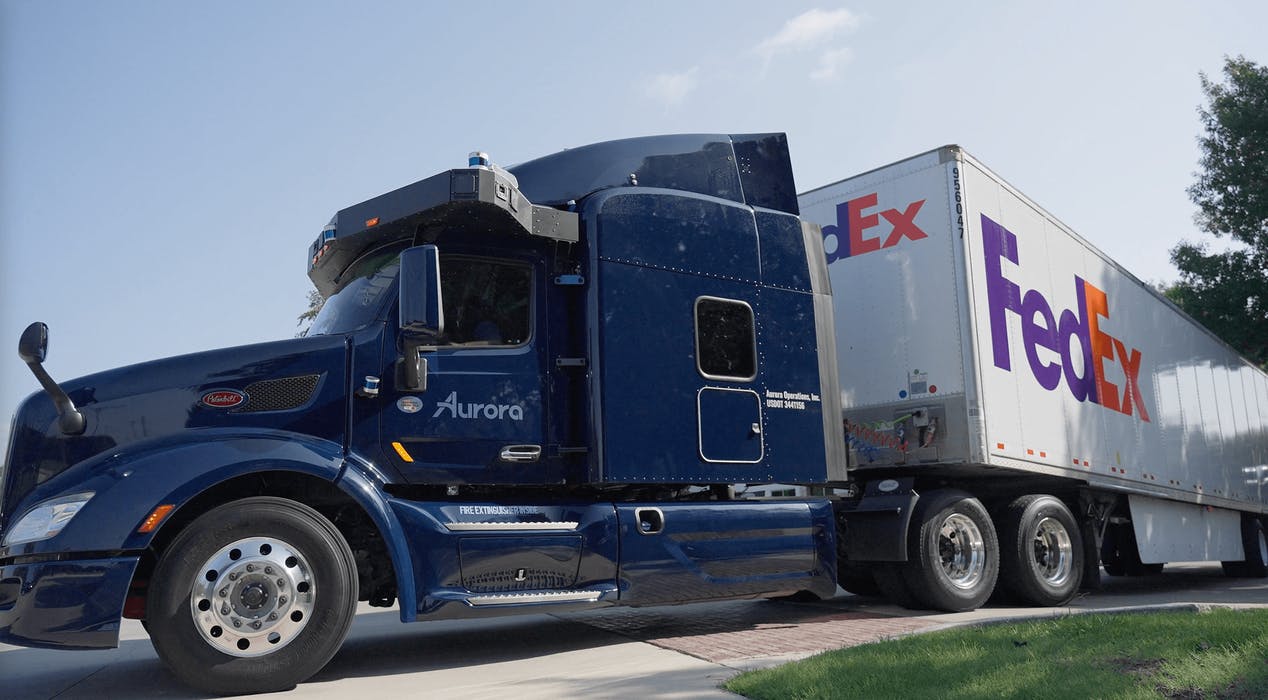Happy Friday. Today is, apparently, National Punctuation Day. In honor of the holiday, the team’s favorite punctuation marks: Dan (...), Jordan (?), Hayden (—).
In today’s edition:
 Medical cannabis tech stack Medical cannabis tech stack
 FedEx’s first automated trucking pilot FedEx’s first automated trucking pilot
 Near space balloons Near space balloons
—Dan McCarthy, Hayden Field, Jordan McDonald
|
|
|
Unsplash
If you want to grow and sell medical-grade cannabis, you’ll need more than just a green thumb and some compost. Think: more scientist in a lab coat, and less soil-caked hippie growing their own supply.
Maitri Genetics, a Pennsylvania-based medical-cannabis cultivator, exemplifies this shift toward science. The state's Department of Health requires medical cannabis growers to attain “a very high level of quality” and consistency, Samantha Mikolajewski, cultivation manager at Maitri, told Emerging Tech Brew.
The tech angle
To hit those quality targets (e.g., extremely low mold and bacteria thresholds), Maitri has constructed a highly controlled grow environment—and technology spanning enterprise software, IoT, and biotech helps provide that grip.
- The 120-person company only operates in Pennsylvania, where recreational cannabis remains illegal, but medical sales generated ~$909 million between April 2020 and March 2021, per Headset Insights, a cannabis data and market intelligence platform.
Maitri also grows all of its cannabis indoors. Not in a greenhouse, but inside a building that’s kept as sterile as possible. That environment shapes which technologies it can employ. Drones don’t make much sense in a building with 10-foot ceilings, for example, but software-managed smart devices and biotech solutions work just fine.
- Maitri uses a software platform called Priva to control variables like light and vapor pressure.
- The company also uses a process called tissue culturing to grow contaminant-free versions of cannabis strains from tiny genetic samples.
“To be able to be in this enclosed space and be providing these plants with everything they need to be at peak performance,” Mikolajewski said, “[is] a real feat of human ingenuity.”
In contrast...Recreational cultivators regularly grow outdoors or in greenhouses, which, in turn, influences the tech they use. Drones are viable for monitoring outside—in fact, Mikolajewski used them in a previous gig on a 17-acre recreational farm in Canada—as are cutting-edge solutions like weed- (the pesky, unwanted kind) killing robots.
And in general, recreational growers could choose to hold themselves to the same standards medical growers have to meet, but no external body is requiring them to adopt the same tech solutions.
“Growing outdoors is maybe looking more at environmental and biological technology,” Mikolajewski said. “Really trying to understand the natural environment and the predictability of, say, a different microclimate, or soil structure, or weather patterns of an area.”
Click here to read the full piece.—DM
|
|
|
Aurora
“I would [drive] 500 miles, and I would [drive] 500 more.” —Autonomous trucks to FedEx, as part of the company’s first foray into (kinda) autonomous driving tech.
Starting this week, FedEx and Aurora Innovation are teaming up on a pilot program in Texas: Paccar-brand trucks, equipped with Aurora’s autonomous driving software, will make ~500-mile round-trip journeys carrying FedEx cargo.
- They’ll make the trek between Dallas and Houston a few times a week.
But, but, but: Although Aurora’s software turns regular 18-wheelers into autonomous vehicles, there’s still always both a safety driver and co-pilot in the car for security.
The shipping and delivery industry has been exploring autonomous delivery options for a while. In 2018, DHL partnered with Nvidia and ZF to test autonomous deliveries; in 2019, Amazon kicked off a pilot program in Seattle; and in 2020, Waymo and UPS teamed up on tests in Phoenix. More recently, in June, Amazon struck a ~$150 million deal with autonomous truck company Plus to retrofit its delivery trucks with AV tech.
- FedEx has been testing its own delivery bots since 2019, and in June of this year, it teamed up with Nuro for smaller-scale autonomous deliveries.
Big picture: For years, experts have called the trucking industry ripe for AV tech. Compared to other driving environments, the highway’s semi-predictable conditions make it a logical entry point—similar roads, long drives, comparable speed limits—and so do the trucking sector’s worsening labor shortages.
But progress is slow, and the pandemic has delayed AV testing and development.—HF
|
|
|
|
Of course, us being us, we’re talking about your investment lineup. With Active Bond Funds, you can add value to your portfolio and the opportunity for outperformance.
Active Fixed Income can balance and diversify your portfolio, even during times of market uncertainty. After all, the last place you want to have unpredictability is in your portfolio.
So whether you’re a novice or consider yourself to be a “sophisticated investor” (good for you, btw), actively managed products could be a smart way to build your portfolio for the long term.
And speaking of the future, Vanguard focuses on smart risk-taking and long-term investment strategies that are aligned with your interests. Why? Because Vanguard is owned by its investors, so your interests are Vanguard's interests.
Get the details on Active Fixed Income right here.
|
|
SPACE
Move over Taylor, there’s a new Swifty in town
|
Unsplash
Near Space Labs, a 2017 startup headquartered in Brooklyn and Barcelona, Spain, focuses on sending satellites nearly into space (think: more Branson than Armstrong), and raised over $13 million in Series A funding earlier this week.
Zooming in...The company’s satellites are actually “Swiftys,” autonomous, wind-powered weather balloons that capture high-quality images for anything from military applications to disaster recovery efforts to autonomous vehicle companies. Near Space Labs focuses its data gathering mostly on urbanized areas going through rapid change, like Fresno or the Bay Area.
- Swiftys can launch from just about anywhere (since they’re balloons, not rockets), and, the company claims, they’re 30% to 45% of the cost of traditional satellite data collection.
- The balloons fly into the stratosphere, which is 12 miles short of space, according to the NOAA.
Near Space Labs says it can capture up to 1,000 sq km of imagery per flight—the equivalent of all five of NYC’s boroughs. It also claims Swiftys are emission-free and capable of flying up to five times a day.
Looking ahead...Eight Swiftys are currently in operation, and Near Space has conducted pilots from Sacramento to Madrid. The company hopes to ramp up to at least 540 flights by the end of 2022.—JM
|
|
|
|
Rethink The Great Resignation. It’s an opportunity to invest in the future (and the people) of your company and build a culture that earns respect. Workhuman has the strategies to help your business foster a sense of belonging, fulfillment, and accountability, despite a hard year of isolation and burnout. To learn more, register for Workhuman’s free digital event, Workhuman Spotlight, today.
|
|
|
Francis Scialabba
Stat: US Energy Secretary Jennifer Granholm estimated that by the end of the decade, the global market for clean energy and carbon-reduction tech will hit $23 trillion, at minimum. For context, that’s about equal to global retail sales in 2020.
Quote: “We don’t think California, New York, or Joe Biden will hit their electric vehicle goals without a technology like this.”—Clay Dumas, a partner at Lowercarbon Capital, re: more sustainable lithium extraction tech.
Read: Thanks to Google, search has become such a dominant behavior that students don’t know how to navigate file directories.
Use your thumbs: Manage your digital assets (like bitcoin, rewards points, gift cards, and cash) in one convenient, tidy place with the Bakkt® App. Unlock the value of your assets and get started today.*
*This is sponsored advertising content
|
|
-
China outright banned crypto trading, four months after it cracked down on mining.
-
Auto companies could lose $210 billion in revenue this year, due to the chip shortage. Also, labor shortages are compounding the chip crisis.
-
Amazon is planning to have high-tech-enabled dressing rooms in its department stores, rumored to open next year.
-
Facebook’s current AR/VR chief, Andrew Bosworth, will become its chief technology officer in 2022.
|
|
Three of the following news stories are true, and one...we made up. Can you spot the odd one out?
-
A winged microchip is officially the smallest human-made flying structure.
-
Australian ravens are attacking Google drones.
-
An asteroid-mining company claims it has found signs of life in the asteroid belt.
-
Microsoft is turning ocean plastic into computer mice.
|
|
A poll of 2,000+ registered US voters found that 80% believe the government ought to do everything in its power to rein in big tech companies. Broken out by party, 83% of Dems and 78% of Republicans responded this way.
- The US regulatory environment has gotten increasingly aggressive toward major tech companies in recent years, particularly Google, Facebook, Apple, and Amazon.
- But so far, the industry has not been curbed in any major way.
|
|
Catch up on the top Emerging Tech Brew stories from the past few editions:
|
|
|
Enjoying the newsletter? Share it with your network to take advantage of our rewards program.
When you reach 5 referrals, we'll send you this Morning Brew sticker sheet.

Hit the button below to learn more and access your rewards hub.
Click to ShareOr copy & paste your referral link to others:
morningbrew.com/emerging-tech/r/?kid=303a04a9
|
|
|
No asteroid-mining company has made this claim...yet.
|
|
|
Written by
Dan McCarthy, Hayden Field, and Jordan McDonald
Was this email forwarded to you? Sign up
here.
|
ADVERTISE
//
CAREERS
//
SHOP
//
FAQ
Update your email preferences or unsubscribe
here.
View our privacy policy
here.
Copyright ©
2021
Morning Brew. All rights reserved.
22 W 19th St, 8th Floor, New York, NY 10011
|
|










